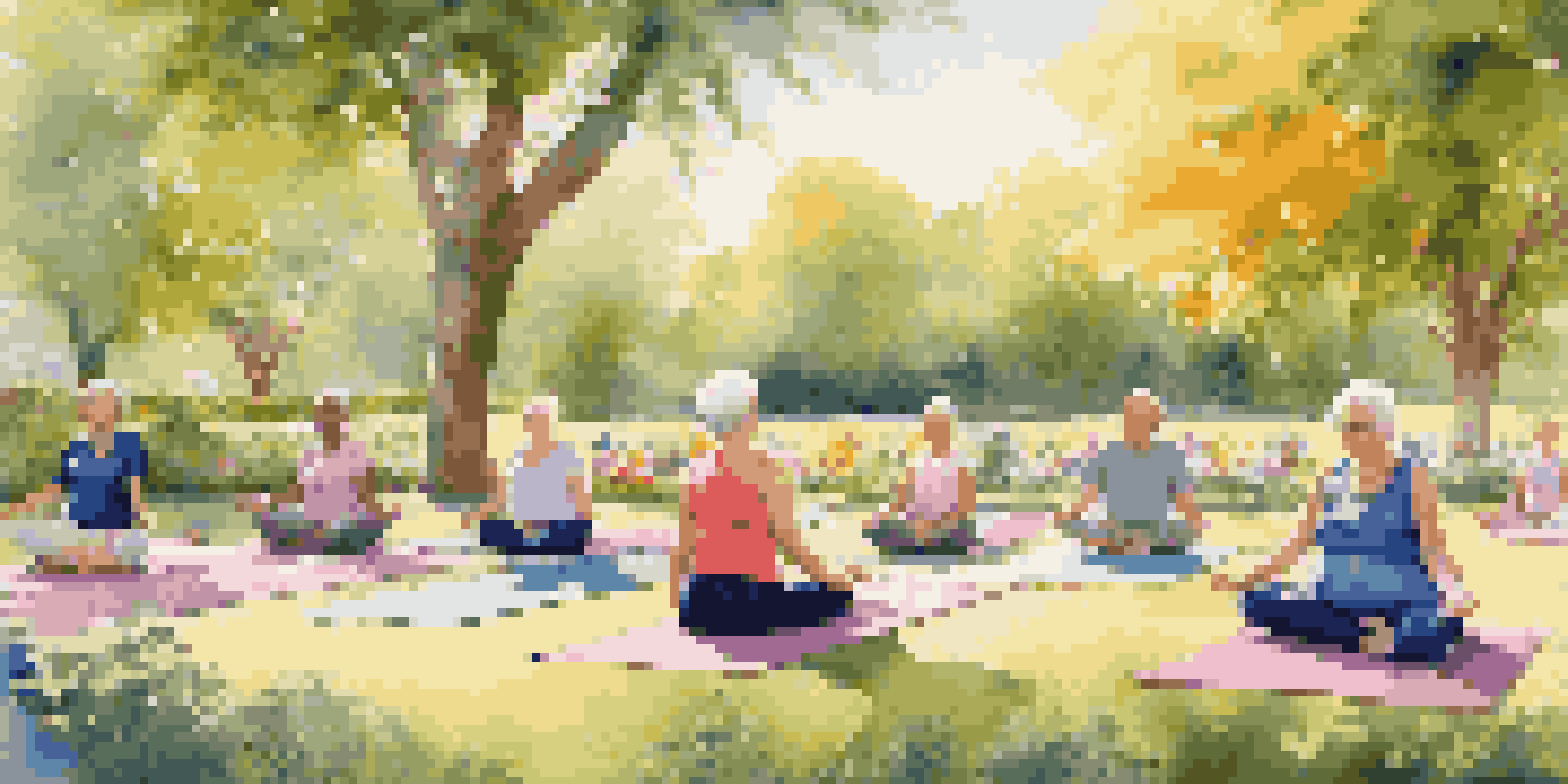The Importance of Routine in Fitness for Seniors

Why Routines Matter for Seniors' Fitness
Establishing a routine can be a game-changer for seniors looking to improve their fitness. Just like a well-planned garden thrives with consistent care, a fitness routine helps seniors maintain their strength and mobility. It creates a sense of predictability, which can be comforting and encourages regular participation.
Take care of your body. It's the only place you have to live.
Moreover, routines can help seniors integrate physical activity into their daily lives, making it less daunting and more enjoyable. Whether it's a morning walk or an afternoon yoga session, having a set time for exercise can transform it from a chore into a cherished part of the day.
Ultimately, the importance of routine lies in its ability to foster a sustainable lifestyle. As seniors engage in regular exercise, they not only improve their physical health but also enhance their mental well-being, leading to a happier, more fulfilling life.
Physical Benefits of a Consistent Exercise Routine
Regular exercise is essential for seniors, as it helps combat the natural decline in muscle mass and strength that occurs with age. Think of muscles as elastic bands; if you don’t stretch and use them, they start to lose their flexibility and strength. A consistent routine can maintain and even improve muscle tone and endurance, which are crucial for daily activities.

Additionally, a regular fitness routine can significantly enhance cardiovascular health. Activities like walking, swimming, or cycling can help strengthen the heart and improve circulation, reducing the risk of heart disease—a common concern for seniors.
Routines Enhance Seniors' Fitness
Establishing a consistent fitness routine helps seniors improve their strength, mobility, and overall well-being.
Moreover, routine exercise can help manage chronic conditions such as arthritis or diabetes. By incorporating gentle movements and strength training into their daily lives, seniors can alleviate symptoms and improve their overall quality of life.
Mental Health Boost from Regular Exercise
Physical activity is not only good for the body; it’s also beneficial for the mind. Engaging in regular exercise releases endorphins, the body's natural mood lifters, which can help combat feelings of anxiety and depression. For seniors, maintaining mental health is just as crucial as physical health.
The secret of change is to focus all of your energy, not on fighting the old, but on building the new.
Establishing a routine can provide a sense of purpose and accomplishment, fostering a positive mindset. Just like tending to a beloved hobby, following a fitness routine can create a sense of achievement that uplifts spirits and encourages social interaction.
Furthermore, group classes or workout sessions can offer social benefits, allowing seniors to connect with peers. This social engagement is vital for combating loneliness and building a supportive community around fitness.
Creating a Routine That Fits Individual Needs
When it comes to fitness for seniors, one size does not fit all. Everyone has different needs, abilities, and preferences. Therefore, creating a personalized routine that aligns with individual goals and interests is crucial for success.
It’s important for seniors to consider their current fitness level and any pre-existing conditions. For instance, someone with joint issues might benefit from low-impact activities like swimming or cycling, while others may enjoy strength training with light weights.
Personalized Fitness is Key
Creating a tailored exercise plan that aligns with individual needs and preferences ensures seniors stay engaged and reap maximum benefits.
Involving a healthcare provider or a fitness professional can help tailor a routine that is safe and effective. This personalized approach ensures that seniors not only stay engaged but also reap the maximum benefits from their fitness journey.
Setting Realistic Goals for Fitness Routines
Setting realistic goals is essential for maintaining motivation in a fitness routine. Instead of aiming for drastic changes, seniors should focus on achievable milestones, like walking for 10 minutes a day or joining a weekly class. These small victories can lead to greater confidence and encourage continued efforts.
For example, a senior might start with three days of light exercise each week and gradually increase the frequency or intensity as they become more comfortable. Celebrating these achievements, no matter how small, reinforces the habit and keeps motivation high.
Moreover, having a clear sense of purpose behind each goal can enhance commitment. Whether it's to improve mobility, socialize more, or simply feel better each day, understanding the 'why' can make all the difference in sticking to a routine.
Overcoming Barriers to Regular Exercise
While the benefits of a fitness routine are clear, many seniors face barriers that can hinder their progress. Common challenges include physical limitations, lack of motivation, or even transportation issues. Recognizing these obstacles is the first step in finding solutions.
For instance, if mobility is a concern, chair exercises or water aerobics can provide a safe alternative. If motivation is low, partnering with a friend or joining a class can create accountability and make workouts more enjoyable.
Support Systems Boost Commitment
Having a strong support network can motivate seniors to stick to their fitness routines and make exercise a more enjoyable experience.
Additionally, exploring virtual fitness options can help seniors who have difficulty traveling to a gym or class. Online resources can offer flexibility and comfort, allowing seniors to engage in fitness from the safety of their homes.
The Role of Support Systems in Fitness Routines
Having a strong support system can significantly enhance a senior’s commitment to their fitness routine. Whether it's family, friends, or community groups, encouragement from others can make a world of difference. Just like a cheering squad at a sports event, support can boost confidence and motivation.
Group activities, like walking clubs or exercise classes, not only provide a structured routine but also foster camaraderie among participants. This social aspect can turn exercise into a fun, shared experience rather than a solitary task.

Moreover, family members can play an active role by joining in on fitness activities, which can strengthen bonds and promote a healthier lifestyle for everyone. Together, they can celebrate achievements and create a culture of fitness and wellness.